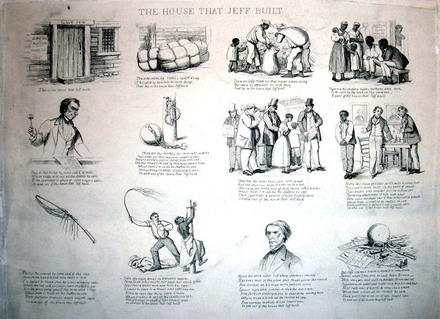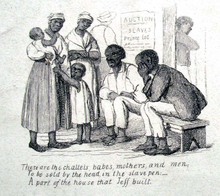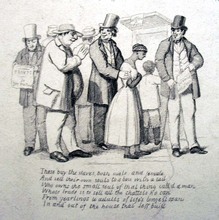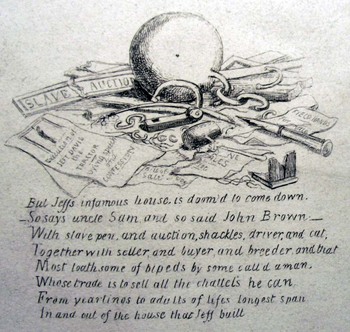Here are the twelve texts:
1.This is the house that Jeff built.
2.This is the cotton, by rebels, called king (Tho’ call’d by Loyalists no such thing) that lay in the house that Jeff built.
3.These are the field chattels that made cotton king, (tho’ call’d by Loyalists no such thing), that lay in the house that Jeff built.
4.These are the chattels babes, mothers, and men, to be sold by the head, in the slave pen;— A part of the house that Jeff built.
5.This is the thing, by some call’d a man, Whose trade is to sell all the chattels he can, From yearlings to adults of life’s longest span; In and out of the house that Jeff built.
6.These are the shackles, for those who suppose their limbs are their own from fingers to toes; And are prone to believe say all that you can, that they shouldn’t be sold by that thing call’d a man; Whose trade is to sell all the chattels he can from yearlings to adults of life’s longest span, in and out of the house that Jeff built.
7.These buy the slaves, both male and female, and sell their own souls to a boss with a tail, who owns the small soul of that thing call’d a man, whose trade is to sell all the chattels he can, from yearlings to adults of life’s longest span, in and out of the house that Jeff built.
8.Here the slave breeder parts with his own flesh to a trader down south, in the heart of secesh, thus trader and breeder secure without fail, the lasting attachment of him with a tail, who owns the small soul of that thing call’d a man, whose trade is to sell all the chattels he can, from yearlings to adult’s of life’s longest span, in and out of the house that Jeff built.
9.This is the scourge by some call’d the cat, Stout in the handle, and nine tails to that, t’is joyous to think that the time’s drawing near when the cat will no longer cause chattels to fear, nor the going, going, gone of that thing call’d a man, whose trade is to sell all the chattels he can, from yearlings to adults of life’s longest span, in and out of the house that Jeff built.
10.Here the slave driver in transport applies, nine tails to his victim, nor heeds her shrill cries, Alas! that a driver with nine tails his own, should be slave to a driver who owns only one, albeit he owns that thing call’d a man, whose trade is to sell all the chattels he can, from yearlings to adults of life’s longest span, in and out of the house that Jeff built.
11.Here’s the arch rebel Jeff whose infamous course, has bro’t rest to the plow and made active the hearse, and invoked on his head every patriots curse, spread ruin and famine to stock the slave pen, and furnish employment to that thing among men, whose trade is to sell all the chattels he can, from yearlings to adults of life’s longest span, in and out of the house that Jeff built.
12.But Jeff’s infamous house is doom’d to come down, so says Uncle Sam and so said John Brown. — With slave pen and auction shackles, driver and cat, together with buyer and seller and breeder and that, most loathsome of bipeds by some call’d a man, whose trade is to sell all the chattels he can, from yearlings to adults of life’s longest span, in and out of the house that Jeff built.




Johnston's design seems to be heavily based upon 'The Political House that Jack Built' an illustrated pamphlet which was produced by the English radical William Hone in 1819 and illustrated by George Cruikshank.
Hone's pamphlet was hugely popular and spawned a plethora of imitations in Regency England during 1819-20 but it's interesting to see the the 'House that Jack Built' design was still in use some 45 years later in the United States.